Menus
- Renewed mid-range all-rounder
- Ergonomics, performance, driving pleasure
- Chassis and equipment
- Technical data Yamaha XJ6 (Diversion)
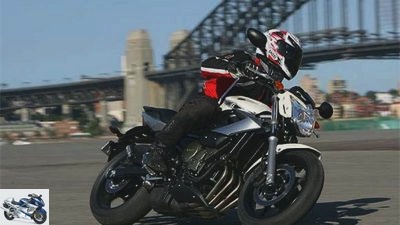
Yamaha
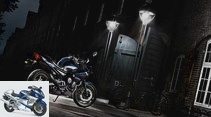
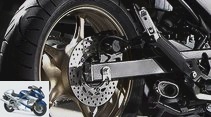
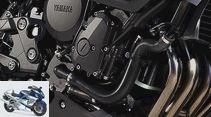
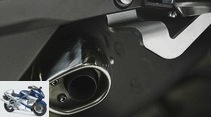
12th photos

Yamaha
1/12
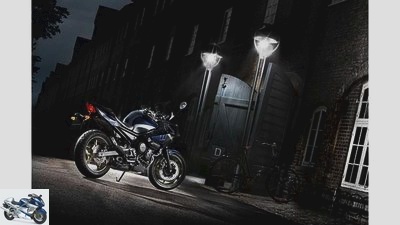
Yamaha
2/12
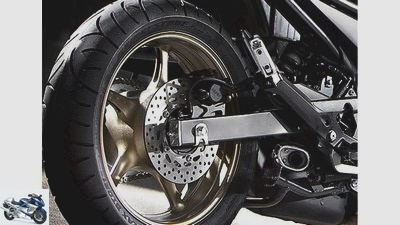
Yamaha
3/12

Yamaha
4/12

Yamaha
5/12
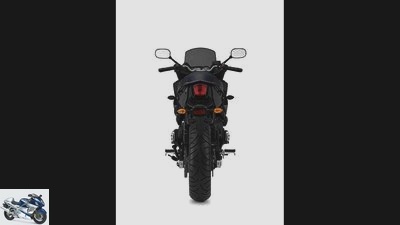
Yamaha
6/12
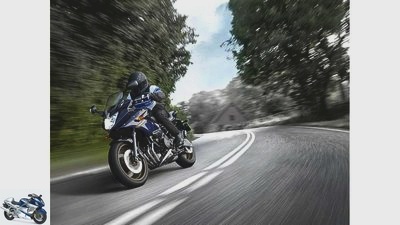
Yamaha
7/12
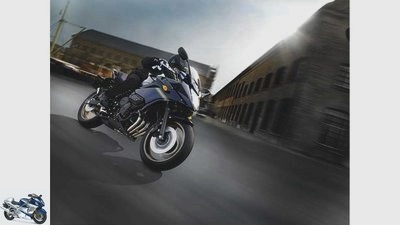
Yamaha
8/12

Yamaha
9/12
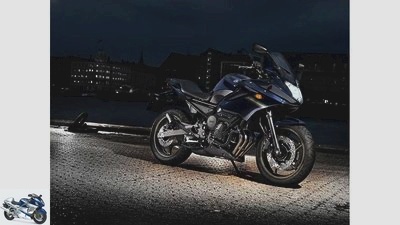
Yamaha
10/12

Yamaha
11/12
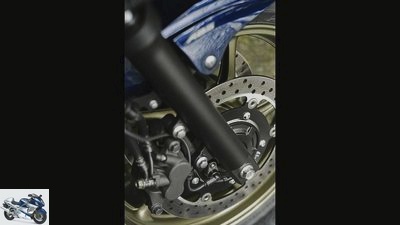
Yamaha
12/12
Yamaha XJ6 / XJ6 Diversion
Renewed mid-range all-rounder
One had no longer expected it. But now Yamaha is returning to the field of mid-range all-rounders where the XJ once did so well. By which? With the new XJ.
Simple is not as easy as you think. Sometimes it just seems to be really difficult. How else could it be explained that Yamaha has left the number-one class par excellence, namely the 600 cubic centimeters and 78 hp, to the competition for years. "moment", some will interject now. "There was the FZ6!" But with all due respect, it was too sporty for many, too much or too listless depending on the model. And too expensive. At least 1500 euros are what separate a basic XJ6 (without fairing and ABS) for 5950 euros from the cheapest FZ6.
Lots of wood. Or the other way around: Less than 6,000 euros for the new XJ is a real competitive price. This also applies if the disguised version "Diversion" with 400 euros more to book and for the ABS a further 545 euros are charged. Even more gratifying: both versions do not look as homely as the price and orientation suggest. On the contrary: the designers succeeded in making a really refreshing appearance, far removed from the Biedermann image that this class is so fond of. Nonetheless, the appearance of both the naked and the disguised XJ is serious and mature enough to be taken for granted by old hands on motorcycles. A positive first impression. This continues with the closer contact. Sit down, drive off? This is the top development goal if you have newcomers, returnees, women, sprightly second car owners and early retirees in focus. No, seriously: the advantages of a motorcycle cooperating instead of looking for its own line, even professionals know very well.
Ergonomics, performance, driving pleasure
Seen in this way, the XJ sisters have everything they need to be successful. A relaxed sitting position behind the not too wide and comfortably cranked handlebar, for example, which is lower and further back than an FZ6, but can be moved 20 millimeters further towards the front wheel by turning the handlebar mount. Or the low seat height of 785 millimeters, which allows smaller people to find a safe stand at all times, while larger ones can be felt, but not folded up excessively. And it also includes an intuitively accessible environment of levers and buttons, a smooth-running, easy-to-dose clutch and a predictable braking system. And of course ABS, which will be available in Germany for the naked XJ practically immediately and for the Diversion from March, but was unfortunately not yet available for the first contact in Australia.
Anyway, MOTORRAD will deliver appropriate impressions and measured values as soon as possible. In other respects, however, definitive statements can already be made. The revision of the FZ6 unit with regard to the new main tasks in the XJ series, in which Yamaha made a lot of effort in contrast to the FZ6 throttling, has been successful. It wasn’t about simply cutting off 20 hp and slipping into the insurance-friendly 78 hp class, but about the much-cited pressure in the lower rev range and in the middle. Yamaha’s measures: 32 instead of 36 millimeters throttle valve diameter, new camshafts with less lift and tamer control times, revised channels, a changed airbox design and a lot of fine tuning in the wide field of injection maps. With the result that the short-stroke four-valve engine reaches the peak of its torque generating power of 60 Newton meters (FZ6: 63 Nm) 1500 rpm earlier than its sporty sister and the maximum output is available at 10000 rpm and thus even 2000 rpm earlier.
So much for the theory. In practice, the new XJ shows not only in the bustle of traffic in Sydney, but also in the charming Australian hinterland that a paradigm shift has taken place in the technical alignment of the four-in-line. Away from the hectic search for more and more speed, towards relaxed gliding in the middle of the speed. In this area, the XJ drive is subjectively noticeably stronger and pleasantly even, only to later noticeably decrease again compared to the FZ6, at the limit of the five-digit range. In view of the significant modifications, this is no wonder? And there is no reason to believe that, given these characteristics, your face would inevitably fall asleep. On the contrary: the new XJ has lively, but not hectic charm, which is also due to the harmonious interplay of chassis and engine. Finely balanced and blessed with a clear tire format (120/70 and 160/60), it does not approach radii of any kind in high spirits, but rather calmly and does not shy away from larger slopes. The first Bridgestone BT 021 tires play the role of an inconspicuous, reliable companion and thus fit seamlessly into the XJ6 philosophy.
Chassis and equipment
Artist
The XJ6 shows what it has to offer: the significantly redesigned four-cylinder is designed as a load-bearing element.
This also applies to the design of the chassis components. Both the non-adjustable 41 mm telescopic fork and the spring strut, which can only be adjusted in the preload, are clearly on the comfortable side, which is more in line with the tourist character of Diversion than with the clearly brisk appearance of the naked sister. The fork in particular reaches its limits when things are going fast or when two people are on board. Then it jumps under dampened over transverse joints or acknowledges bumps in an inclined position with clear rocking movements. In addition, does it go during heavy braking maneuvers? and they are easily possible with the double piston system and especially with ABS ?? very deep in the soft knees. The XJ6 is not designed for such a sporty driving style, argues Yamaha and refers to the four kilogram lighter FZ6 with aluminum bridge frame and tighter chassis. You can accept that. Just like how you can live with the edgy vibrations that particularly affect the seat bench and footrests in the middle speed range and are surprisingly more pronounced with the Diversion than with the bare XJ. And while we’re at it: The play in the drive train is a bit big and the throttle response is not overly gentle despite all efforts.
So, that was it with the grumbling, the positive aspects clearly outweigh the other. In addition, they relativize themselves when looking at the price list. The bottom line is that Yamaha has succeeded in doing exactly what was already convincing with the XJ of the past. An affordable, uncomplicated but by no means boring bike for everyday use, which also cuts a fine figure as a brisk naked woman in an urban setting and is also suitable as a diversion with proper wind protection for longer stages. Seen in this way, nothing should stand in the way of the success of the past few days. We cheerfully call out: Hello again, XJ!
Technical data Yamaha XJ6 (Diversion)
Artist
engine
Water-cooled four-cylinder in-line engine, two overhead, chain-driven camshafts, four valves per cylinder, bucket tappets, wet sump lubrication, injection, Ø 32 mm, regulated catalytic converter, 330 W alternator, 12 V / 10 Ah battery, mechanically operated multi-plate oil bath clutch, six-speed gearbox, O -Ring chain, secondary ratio 46:16.
Bore x stroke 65.5 x 44.5 mm
Cubic capacity 600 cm³
Compression ratio 12.2: 1
Rated output 57.0 kW (78 hp) at 10,000 rpm
Max. Torque 60 Nm at 8500 rpm
landing gear
Double loop frame made of steel, telescopic fork, Ø 41 mm, two-arm swing arm made of steel, central spring strut, directly hinged, adjustable spring base, double disc brake at the front, Ø 298 mm, double-piston floating calipers, disc brake at the rear, Ø 245 mm, single-piston floating caliper.
Cast aluminum wheels 3.50 x 17; 4.50 x 17
Tires 120/70 ZR 17; 160/60 ZR 17
Dimensions + weights
Wheelbase 1440 mm, steering head angle 64.0 degrees, caster 104 mm, spring travel f / h 130/130 mm, seat height 785 mm, weight with a full tank * 205 kg (211 kg), tank capacity 17.3 liters.
Two year guarantee
Colors yellow, white, black (blue, gray, red)
Price ** 5950 euros (6350 euros)
Additional costs around 170 euros
* Additional weight with ABS: four kilograms; ** Surcharge ABS: 545 euros
Related articles
-
Honda CBR 650 F, Suzuki GSX 650 F, Yamaha XJ6 Diversion F in the test
fact 46 photos fact 1/46 The Suzuki as a solid all-rounder, the Yamaha as a lively fun bike. Honda is changing the CB 650 F with the casing, on the other…
-
Yamaha MT-125 ABS in the driving report
fact 16 photos fact 1/16 Yamaha MT-125 ABS. fact 2/16 Yamaha MT-125 ABS. fact 3/16 Yamaha MT-125 ABS. fact 4/16 Yamaha MT-125 ABS. fact 5/16 Yamaha…
-
BMW K 100 and Yamaha XJ 900 N in comparison
wolf 23 photos wolf 1/23 The two classic naked bikes BMW K 100 and Yamaha XJ 900 N in comparison. The two strong nudes have more in common than it seems….
-
Comparison test middle class BMW F 650 GS Honda Deauville Yamaha XJ 600 S Diversion Tour
Comparison test middle class BMW F 650 GS Honda Deauville Yamaha XJ 600 S Diversion Tour City-Country-River One-, two- and four-cylinder, all equipped…
-
Yamaha 15th photos Yamaha 1/15 … in which the V4 is screwed in four places and has a load-bearing function. Yamaha 2/15 Yamaha’s new Vmax is a beast….
-
Driving report Yamaha WR 250-450 F
Driving report Yamaha WR 250/450 F Full pack What is good for the crossers can’t hurt for the hard enduro bikes. That’s why MOTORRAD plowed through the…
-
BMW G 310 R and Yamaha MT-03 in the test
25th photos 1/25 BMW G 310 R and Yamaha MT-03 in comparison test. 2/25 BMW G 310 R and Yamaha MT-03 in comparison…
-
Jahn Review Yamaha WR 250 X Single cylinder of the future With its sophisticated technology, the Yamaha WR 250 X shows the way into the future of sporty…
-
Bilski Test: Yamaha FZ1 ABS FZ1: Yamaha’s naked athletes in the test Because Yamaha’s naked athletes do not act as confidently as the displacement…
-
Honda CBF 600, Kawasaki ER-6n, Suzuki Gladius 650 and Yamaha XJ6
Artist Honda CBF 600, Kawasaki ER-6n, Suzuki Gladius 650 and Yamaha XJ6 Comparison test all-rounder Looking for a partner in the world of all-rounders?…